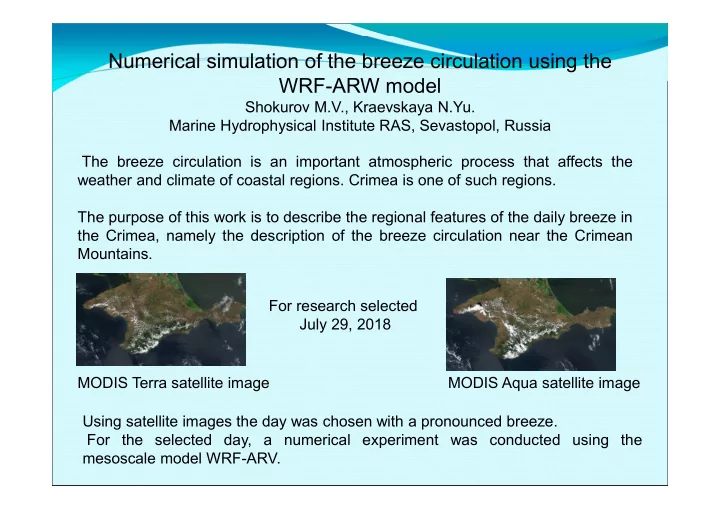

Numerical simulation of the breeze circulation using the WRF-ARW model Shokurov M.V., Kraevskaya N.Yu. Marine Hydrophysical Institute RAS, Sevastopol, Russia The breeze circulation is an important atmospheric process that affects the weather and climate of coastal regions. Crimea is one of such regions. The purpose of this work is to describe the regional features of the daily breeze in the Crimea, namely the description of the breeze circulation near the Crimean Mountains. For research selected July 29, 2018 MODIS Terra satellite image MODIS Aqua satellite image Using satellite images the day was chosen with a pronounced breeze. For the selected day, a numerical experiment was conducted using the mesoscale model WRF-ARV.
Numerical simulation of sea breeze circulation A numerical mesoscale model WRF-ARW was used for the study. Input data: Global operative analysis NCEP GDAS / FNL 0.25. The data has a resolution of 0.25 degrees in space, 6 hours in time. For the simulation of sea breeze circulation were used: 2 levels of nested grids with a 6 and 2 km spatial resolution, 32 levels vertically. The simulation was carried out for 1 day.
Sea breeze in the plains and mountains 1. Section along which considered a vertical structure in the flat part of the Crimea 2. Section along which considered a vertical structure in the mountains Horizontal (arrows) and vertical (color) velocity components (m / s) at 15 Local time Based on the results of numerical simulation, the structure of the sea breeze circulation in the Crimea is described. The classical elements of the breeze characteristic of the flat part of the Crimea are noted. The unique phenomenon of collision of breeze gravity currents is emphasized. It is the characteristic of land areas of sufficiently small size. The greatest attention is paid to the features of the breeze in the mountains associated with the influence of the mountain relief.
Thank you for your attention krayevskaja@gmail.com
Recommend
More recommend